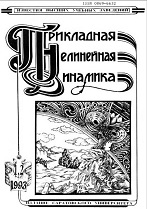|
NONLINEAR DYNAMICS AND NEUROSCIENCE
Postulates of the cognitive theory of thinking and their consequences
V. A. Antonetsab
a National Research Lobachevsky State University of Nizhny Novgorod, Russia
b Federal Research Center Institute of Applied Physics,
Russian Academy of Sciences, Nizhny Novgorod, Russia
Abstract:
Purpose of the work is to create a theoretical model of the thinking process, considered as a set of operations for the formation of cognitive generalizations of the level of categories (concepts). Method for creating a theoretical model is based on the approach used in natural sciences. It involves the selection of a small number of reliable facts, which are accepted as true on the basis of their evidence. On the basis of these facts, established in various scientific disciplines, the axioms of the proposed theory are formulated. Further, from the accepted axioms, they are logically deduced in the form of consequences: a) already known results that could be obtained in various fields of science, including those differing in the content of research, and therefore previously perceived as not related to each other; b) predictions of new connections and patterns in the study area. Results of the work are that it was possible to propose a version of the postulate dynamic theory of thinking, in which the main variables are the number of concepts formed, lost, realized and unconscious by the subject. The introduced postulates and variables made it possible to consider two types of models at the moment. Balanced integrodifferential models that describe the accumulation of the volume of conscious and unconscious concepts, as well as combinatorial models that describe the interactions of concepts. Conclusion. The proposed version of the dynamic thinking model made it possible to construct reasonable theoretical descriptions of the process of spontaneous language acquisition by bilingual children in a bilingual environment and a person's ability to compare semantically heterogeneous objects with each other. The logical scheme of the approach and the concepts used in it made it possible to connect some facts known in psychology and in an explicitly compact formulation of the difference in the structure of scientific and artistic generalizations of the picture of the world.
Keywords:
theory of thought, categories, plurality of consciousnesses.
Received: 09.12.2021
Citation:
V. A. Antonets, “Postulates of the cognitive theory of thinking and their consequences”, Izvestiya VUZ. Applied Nonlinear Dynamics, 30:4 (2022), 480–494
Linking options:
https://www.mathnet.ru/eng/ivp491 https://www.mathnet.ru/eng/ivp/v30/i4/p480
|

|




 Contact us:
Contact us: Terms of Use
Terms of Use
 Registration to the website
Registration to the website Logotypes
Logotypes








 Citation in format
Citation in format 